| Listing 1 - 10 of 40 | << page >> |
Sort by
|
Book
ISBN: 1281800716 9786611800710 2759803244 9782759803248 9781281800718 6611800719 Year: 2008 Publisher: Les Ulis
Abstract | Keywords | Export | Availability | Bookmark
 Loading...
Loading...Choose an application
- Reference Manager
- EndNote
- RefWorks (Direct export to RefWorks)
Because neutron physics is the essential part of reactor physics, it is the main subject taught to students of Nuclear Engineering. This book takes an instructional approach for that purpose. Neutron Physics is also intended for all physicists and engineers involved in development or operational aspects of nuclear power.
Neutrons. --- Atoms --- Baryons --- Matter --- Particles (Nuclear physics) --- Constitution
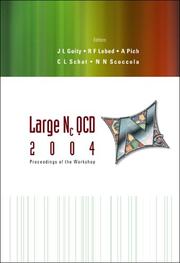
ISBN: 1281897310 9786611897314 9812701729 9789812701725 9812563997 Year: 2005 Publisher: Hackensack, N.J. : World Scientific,
Abstract | Keywords | Export | Availability | Bookmark
 Loading...
Loading...Choose an application
- Reference Manager
- EndNote
- RefWorks (Direct export to RefWorks)
The large Nc limit plays a fundamental role in the study of non-abelian gauge theories such as quantum chromodynamics (QCD). Since its discovery in 1974 by 't Hooft, the 1/Nc expansion has provided crucial insights into the non-perturbative aspects of gauge theories. The expansion implemented at the effective theory level is one of the fundamental tools currently in use in hadronic physics; there are important effects and relations that follow from the 1/Nc expansion, which held remarkably well in the real world with Nc = 3. The 1/Nc expansion also plays a central role in the recently discover
Quantum chromodynamics --- Baryons --- Fermions --- Hadrons --- Heavy particles (Nuclear physics)
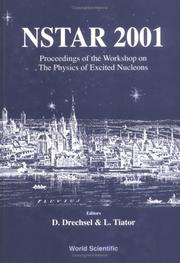
ISBN: 1281956465 9786611956462 9812810870 9789812810878 9781281956460 9789810247607 9810247605 Year: 2001 Publisher: Singapore River Edge, NJ World Scientific
Abstract | Keywords | Export | Availability | Bookmark
 Loading...
Loading...Choose an application
- Reference Manager
- EndNote
- RefWorks (Direct export to RefWorks)
The study of N*s can provide us with critical insights into the nature of QCD in the confinement domain. The keys to progress in this domain are the identification of its important degrees of freedom and the effective forces between them. The nucleon is the simplest system in which the nonabelian character of QCD is manifest. There are Nc quarks in a baryon because there are Nc colors, and as a consequence Gell-Mann and Zweig were forced to introduce the quarks in order to describe the octet and decuplet baryons. This volume gives a status report on the recent experimental and theoretical results in the field of nucleon resonance physics. A wealth of new high precision data was presented from facilities around the world, such as BES, BNL, ELSA, GRAAL, JLab, MAMI, MIT/Bates, SPring8, and Yerevan. Particular emphasis was laid on polarization degrees of freedom and large acceptance detectors as precision tools for studying small but important transition amplitudes, and the helicity (spin) structure of the nucleon. There were new results describing the nucleon resonance structure on the basis of quantum chromodynamics, either directly in terms of quarks and gluons by means of lattice gauge theory, or in terms of hadrons in the framework of chiral field theories. A status report on duality showed the surprising connections between the physics of the low energy nucleon resonance region and the realm of quark structure functions in deep inelastic scattering. Finally, this volume contains a summary report of the BRAG workshop, devoted to the analysis of baryon resonances.
Hadrons --- Particles (Nuclear physics) --- Baryons --- Fermions --- Heavy particles (Nuclear physics)
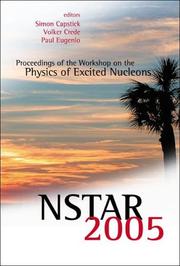
ISBN: 1281373028 9786611373023 9812773339 9789812773333 9789812568397 9812568395 9781281373021 9812568395 Year: 2006 Publisher: Singapore ; Hackensack, N.J. : World Scientific,
Abstract | Keywords | Export | Availability | Bookmark
 Loading...
Loading...Choose an application
- Reference Manager
- EndNote
- RefWorks (Direct export to RefWorks)
Brings together experts on the quark-gluon structure of matter as it applies to nucleon resonance physics. This book contains contributions that discuss the findings in areas such as meson production via electromagnetic and hadronic reactions, baryon resonance structure in chiral and lattice QCD approaches, and more.
Hadrons --- Particles (Nuclear physics) --- Baryons --- Fermions --- Heavy particles (Nuclear physics)
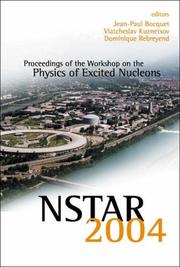
ISBN: 1281898333 9786611898335 981270227X 9789812702272 9789812560902 9812560904 9781281898333 9812560904 6611898336 Year: 2004 Publisher: River Edge, NJ : World Scientific,
Abstract | Keywords | Export | Availability | Bookmark
 Loading...
Loading...Choose an application
- Reference Manager
- EndNote
- RefWorks (Direct export to RefWorks)
This book covers recent advances in the field of nucleon resonances presented at the IX International Workshop on the Physics of Excited Baryons, NSTAR2004. A complete overview of the most recent experimental results obtained worldwide on baryon spectroscopy is presented together with theoretical progress on related topics ranging from resonance parameters extraction to lattice-QCD calculations through effective field theory. Of particular interest, a large part of the book is devoted to exotic states with quantum numbers of pentaquarks, whose recent discovery represents a new chapter in hadro
Hadrons --- Particles (Nuclear physics) --- Baryons --- Fermions --- Heavy particles (Nuclear physics)
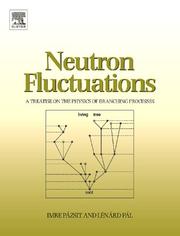
ISBN: 1281029149 9786611029142 0080550436 0080450644 9780080450643 9780080550435 Year: 2008 Publisher: Amsterdam Boston Elsevier
Abstract | Keywords | Export | Availability | Bookmark
 Loading...
Loading...Choose an application
- Reference Manager
- EndNote
- RefWorks (Direct export to RefWorks)
The transport of neutrons in a multiplying system is an area of branching processes with a clear formalism. This book presents an account of the mathematical tools used in describing branching processes, which are then used to derive a large number of properties of the neutron distribution in multiplying systems with or without an external source. In the second part of the book, the theory is applied to the description of the neutron fluctuations in nuclear reactor cores as well as in small samples of fissile material. The question of how to extract information about the system under s
Branching processes. --- Neutrons. --- Atoms --- Baryons --- Matter --- Particles (Nuclear physics) --- Processes, Branching --- Stochastic processes --- Constitution
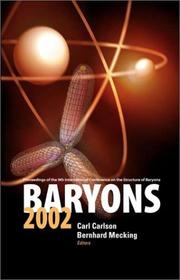
ISBN: 1281906298 9786611906290 9812704884 9789812704887 981238409X 9789812384096 Year: 2003 Publisher: Singapore River Edge, NJ World Scientific
Abstract | Keywords | Export | Availability | Bookmark
 Loading...
Loading...Choose an application
- Reference Manager
- EndNote
- RefWorks (Direct export to RefWorks)
This book deals with the latest developments in the area of three-quark systems. Emphasis is given to the discussion of new experimental results in the areas of form factors, unpolarized and polarized structure functions, and baryon structure and spectroscopy. Of particular interest are the new theoretical developments in the area of generalized parton distributions and lattice quantum chromodynamics.
Baryons --- Baryon resonance --- Resonance, Baryon --- Nuclear magnetic resonance --- Fermions --- Hadrons --- Heavy particles (Nuclear physics)
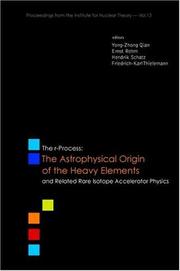
ISBN: 128189852X 9786611898526 9812702474 9789812702470 9789812560322 9812560327 Year: 2004 Publisher: Hackensack, NJ World Scientific
Abstract | Keywords | Export | Availability | Bookmark
 Loading...
Loading...Choose an application
- Reference Manager
- EndNote
- RefWorks (Direct export to RefWorks)
The r-process is a major mechanism for producing elements heavier than Fe. In this book, a summary of recent developments in theoretical, experimental and observational studies of the r-process are presented in 25 contributions. The collected papers are up to date, comprehensive and yet concise. The topics covered include experiments on nuclei far from stability, nuclear theory input for the r-process, observational and theoretical studies on abundances of heavy nuclei, and astrophysical models of the r-process. The proceedings have been selected for coverage in: Index to Scientific & Techn
Fast neutrons --- Neutrons --- Atoms --- Baryons --- Matter --- Particles (Nuclear physics) --- Capture --- Constitution
Book
ISBN: 1282236113 9786612236112 3540851445 9783540851448 3540851437 9783540851431 Year: 2008 Publisher: Berlin, Heidelberg Springer Berlin Heidelberg
Abstract | Keywords | Export | Availability | Bookmark
 Loading...
Loading...Choose an application
- Reference Manager
- EndNote
- RefWorks (Direct export to RefWorks)
c Societa a Italiana di Fisica / Springer-Verlag 2008 The 11th Workshop on The Physics of Excited Nucleons, NSTAR 2007, was held at the University of Bonn, Germany,fromSeptember5–8,2007.ItwasthelatestofaseriesofsuccessfulconferencesattheRensselaerPolytechnic Institute (1988), Florida State University (1994 and 2005), Je?erson Lab (1995 and 2000), INT Seattle (1996), GWU ? Washington (1997), ECT Trento (1998), Mainz (2001), Pittsburgh (2002) and the LPSC Grenoble (2004). A Baryon Resonance Analysis Group (BRAG) meeting immediately before the workshop focused especially on the physical meaning of bare and dressed scattering matrix singularities. A focus workshop on? photoproduction rounded o? the NSTAR 2007. The goal of NSTAR 2007 was to bring together experts on all areas of physics relevant to baryon spectroscopy, both in experiment and theory. Latest results were presented in 30 plenary talks and 34 parallel contributions, the proceedings of which are collected in this volume. The workshop was attended by 123 scientists of 41 universities and laboratories from 16 countries. Exciting new high-precision data were shown from facilities in Asia, the US and Europe, e.g. BES, BNL, COSY, ELSA, GRAAL, JLab, MAMI and LEPS. Large-acceptance detectors provide complete angular distributions in many reaction channels. Particular emphasis is put on the measurement of single and double polarisation observables such that many new polarization measurements can be expected in forthcoming meetings.
Particles (Nuclear physics) --- Quarks --- Baryons --- Nuclear Physics, Heavy Ions, Hadrons. --- Baryons -- Congresses. --- Quarks -- Congresses. --- Physics. --- Nuclear physics. --- Heavy ions. --- Hadrons. --- Fermions --- Hadrons --- Heavy particles (Nuclear physics) --- Atomic nuclei --- Atoms, Nuclei of --- Nucleus of the atom --- Physics --- Ions
Book
ISBN: 1629481009 9781629481005 9781629480992 1629480991 Year: 2013 Publisher: Hauppauge, New York : Nova Science Publishers,
Abstract | Keywords | Export | Availability | Bookmark
 Loading...
Loading...Choose an application
- Reference Manager
- EndNote
- RefWorks (Direct export to RefWorks)
In this book the authors present current research in the study of neutron scattering. Topics discussed in this compilation include the current status and activities of small-angle neutron scattering instrument-SANS-U; analyzing the phase behavior of polymer blends by small-angle neutron scattering; small-angle neutron scattering and the study of nanoscopic lipid membranes; evaluation of the thermodynamic properties of hydrated metal oxide nanoparticles by INS techniques; ultra-low temperature sample environment for neutron scattering experiments; and strengths of the interactions in Y Ba2Cu3O6
Neutrons --- Nucleon-nucleon scattering. --- Nucleon scattering --- Nucleon-nucleon interactions --- Scattering (Physics) --- Atoms --- Baryons --- Matter --- Particles (Nuclear physics) --- Scattering --- Research. --- Constitution
| Listing 1 - 10 of 40 | << page >> |
Sort by
|

 Search
Search Feedback
Feedback About UniCat
About UniCat  Help
Help News
News